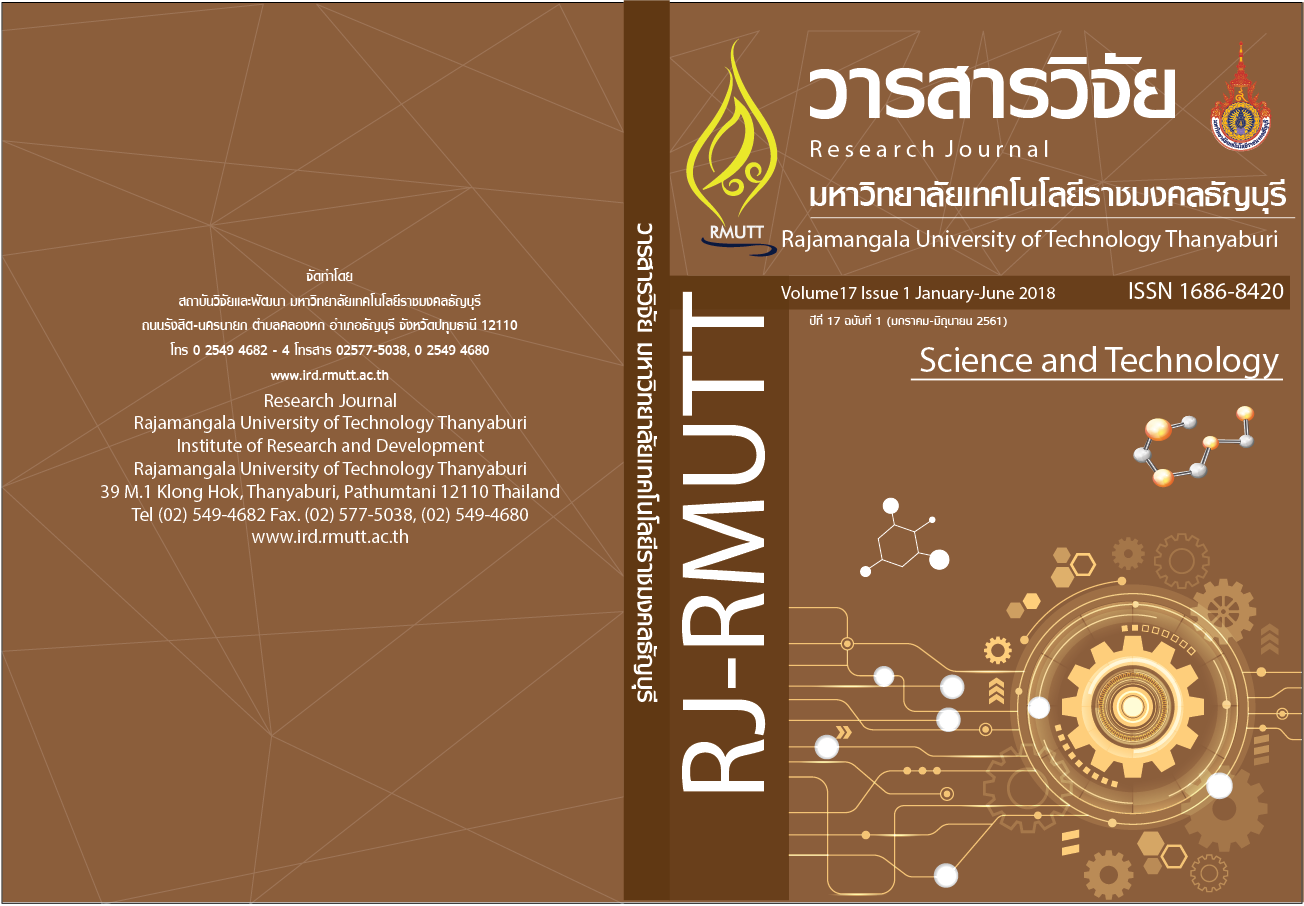The combination effect of tetracycline with bitter gourd (Momordica charantia) fruit extract and gallic acid on antimicrobial against pathogens
Main Article Content
Abstract
Antibiotic drugs resistant of the pathogenic microorganism problem has increased rate in the current. The single antibiotic substances often potential decrease for therapy. Thus, the multiple combinations of antimicrobial agents are a new strategy for improving this problem. Natural products are the sources of antimicrobial substances which are developed for antibiotic combination. In this research, the antimicrobial effect of phytochemical compounds, gallic acid and caffeic acid, bitter gourd fruit extracts and tetracycline which is representative of antibiotic drug on the growth of Pseudomonas aeruginosa ATCC 27853 and Staphylococcus aureus ATCC 25923 were determined. Then, the combined effects of bitter gourd fruit extracts and gallic acid with tetracycline were determined using checkerboard assay and analyzed by FIC Index. The result showed that all treatment samples inhibited growth of both pathogenic bacterial cells in vitro. The MIC values of bitter gourd fruit extracts, gallic acid and tetracycline on Ps. aeruginosa were 12000, 2000 and 16 µg/ml, respectively. Additionally, MIC dose on S. aureus showed 16000, 6000 and 1 µg/ml, respectively. Antagonistic effect was observed with the combination of bitter gourd fruit extracts and tetracycline as evidenced by high values of the FIC index on Ps. aeruginosa and S. aureus around 5.33 and 6.50, respectively. However, the combination effect of gallic acid and tetracycline showed an additive effect with the values of the FIC index of Ps. aeruginosa and S. aureus 3.00 and 0.83, respectively
Article Details
References
Mesaros, N., P. Nordmann, P. Plésiat, M. Roussel-Delvallez, J. Van Eldere, Y. Glupczynski, Y. Van Laethem, F. Jacobs, P. Lebecque, A. Malfroot,P.M. Tulkens, F. Van Bambeke. (2007). Pseudomonas aeruginosa:resistance and therapeutic options at the turn of the new millennium. Clin Microbiol Infect, 13(6), 560-578.
Jayaraman, P., M.K. Sakharkar, C.S. Lim, T.H. Tang, K.R. Sakharkar. (2010). Activity and interactions of antibiotic and phytochemical combinations against Pseudomonas aeruginosain vitro. International Journal of Biological Sciences, 6(6), 556-568.
Singh,S.B., J.F. Barrett. (2006). Empirical antibacterial drug discovery -Foundationin natural products.Biochemical Pharmacology, 71(7), 1006-1015.
Foster, T.J. (2004). The Staphylococcus aureus"superbug".Journal of Clinical Investigation, 114(12), 1693-1696
Niederman,M.S., L.A. Mandell, A. Anzueto, J.B. Bass, W.A. Broughton, G.D. Campbell, et al. (2001,). Guidelines for the management of adults with community-acquired pneumonia. Diagnosis, assessment of severity, antimicrobial therapy, and prevention. American Journal of Respiratory and Critical Care Medicine, 163(7), 1730-1754.
El Solh,A.A., A. Alhajhusain. (2009). Update on the treatment of Pseudomonas aeruginosapneumonia. Journal of Antimicrobial Chemotherapy, 64(2), 229-238.
Ozcelik, B., M. Kartal, I. Orthan. (2011). Cytotoxicity, antiviral andantimicrobial activities of alkaloids, flavonoids, and phenolic acids. Pharmaceutical Biology, 49(4), 396-402.
Costa,J.G., E.M. Nascimento, A.R. Campos, F.F. Rodrigues. (2010). Antibacterial activity of Momordica charantia (Curcubitaceae) extracts andfractions.Journal of Basic and Clinical Pharmacy, 2(1), 45-51.
Coutinho,H.D., J.G. Costa, E.O. Lima, V.S. Falcão-Silva, J.P.Jr. Siqueira. (2008). Enhancement of the antibiotic activity against a multiresistant Escherichia coli by Mentha arvensisL. and chlorpromazine. Chemotherapy, 54(4), pp. 328-330.
Coutinho,H.D., J.G. Costa, E.O.Lima, V.S. Falcão-Silva, J.P.Jr. Siqueira. (2009). Herbal therapy associated with antibiotic therapy: Potentiation of the antibiotic activity against methicillin -Resistant Staphylococcus aureusby Turnera ulmifolia L. BMC Complementaryand Alternative Medicine, 1, 9-13.
Garo, E., G.R. Eldridge, M.G. Goering, E. DeLancey Pulcini, M.A. Hamilton, J.W. Costerton, G.A. James. (2007). Asiatic acid and corosolic acid enhance the susceptibility of Pseudomonas aeruginosabiofilms to tobramycin. Antimicrob Agents Chemother, 51(5), 1813-1817.
Lu, Y.L., Y.H. Liu, W.L. Liang, J.H. Chyuan, K.T.Cheng,H.J. Liang, W.C. Hou. (2011). Antibacterialand cytotoxic activities of different wild bitter gourd cultivars (Momordica charantiaL. var. abbreviata Seringe). Botanical Studies, 52(4), 427-434.
Grover, J.K., S.P. Yadav. (2004).Pharmacologicaactions and potentialuses of Momordica Research Journal Rajamangala University of Technology Thanyaburi, ISSN 1686-8420, Vol 17, Issue 1, 201821charantia: a review. Journal of Ethnopharmacology, 93, 123-132.
Leelaprakash, G., J. Caroline Rose, B.M. Gowtham. (2011). Invitro antimicrobialand antioxidant activity of Momordica charantialeaves. Pharmacophore, 2(4), 244-252.
Chopra,I., M. Roberts. (2001). Tetracycline antibiotics: Mode of action, applications, molecular biology, and epidemiology of bacterial resistance. Microbiology and Molecular Biology Reviews, 65(2), 232-260.
Antonysamy, J. (2017). In vitro phytochemicaland antibacterial studies on Rhinacanthus Nasutus (L.) Kurz -A medicinally important plant. Journal of Microbiology and Experimentation 4(2), 1-4.
Shah, M.A., R. Khalil, Z. Ul-Haq, P.Panichayupakaranant. (2017). α-Glucosidaseinhibitory effect of rhinacanthins-rich extract from Rhinacanthus nasutusleaf and synergistic effect in combination with acarbose. Journal of Functional Foods, 36, 325-331.
Thathaisong, U., and S. Sangnual. (2011). Synergistic Effect of Alpha-Mangostin and Gentamicin against Methicillin-resistant Staphylococcus aureus Isolated from King Narai Hospital. Burapha Science Journal, 16(2): 89-96.
J.N. Spoorthi, T. Vishwanatha, V. Reena, B.C. Divyashree. (2011). Antibiotic synergy test. Checkerboard method on multidrug resistant Pseudomonas aeruginosa. International Research Journal of Pharmacy, 2(12), 196-198.
ธิดา สมใจ และคณะ (2559, พฤศจิกายน). การศึกษาผลของสารสกัดผลมะระขี้นกต่อการเติบโตของแบคทีเรียก่อโรคและ Staphylococcus aureusสายพันธุ์ต่าง ๆ 7 การประชุมวิชาการงานเกษตรนเรศวร ครั้งที่ 14, พิษณุโลก.
Yilmaz, Y., R.T. Toledo. (2004). Major flavonoids in grape seeds and skins: antioxidant capacity of catechin, epicatechin, and gallic acid. Journal of Agricultural and Food Chemistry, 52(2), 255-260.
Maurya,D.K., N. Nandakumar, T. P.A. Devasagayam. (2011). Anticancer property of gallic acid in A549, a human lung adenocarcinoma cell line, and possible mechanisms. Journal of Clinical Biochemistry and Nutrition, 48(1). 85-90.
Borges,A., M.J. Saavedra, M. Simões. (2012). The activity of ferulic and gallic acids in biofilm prevention and control of pathogenic bacteria. Biofouling, 28(7), 755-67.
Rubin, J.E., K.R. Ball, M. Chirino-Trejo. (2011). Antimicrobial susceptibility of Staphylococcus aureus and Staphylococcus pseudintermedius isolated from various animals. Canadian Veterinary Journal, 52(2), 153-157.
Borges, A., C. Ferreira, M.J. Saavedra, M. Simoes. (2013). Antibacterial activity and mode of action of ferulic and gallic acids against pathogenic bacteria. Microbial drug resistance, 19(4), 1-9

